In 2021, severe weather impacted every region of Italy. For example, on 4 October 2021, the entire country was hit by 20 severe weather events in one day, including tornadoes, hailstorms, windstorms and torrential rainfall, which caused damage to cities and rural areas, primarily in the northwestern region. The storms devastated fields, pastures, stables and agricultural vehicles; blocked roads; caused landslides; and broke three national climate records within a few hours.
- In the municipalities of Urbe and Montenotte Inferiore, 368 mm of rain fell in three hours and 490 mm of rain fell in six hours.
- In Rossiglione 733 mm of rain fell in 12 hours.1
Extreme weather event trends
From 2010 to 2021, the number of extreme weather events in Italy trended upward, as shown in the chart in Figure 1.
- The number of extreme weather events tripled from 2017 to 2020
- From January to October 2021, 130 extreme weather events were reported
Figure 1: Number of extreme weather events in Italy from 2010 to October 20212
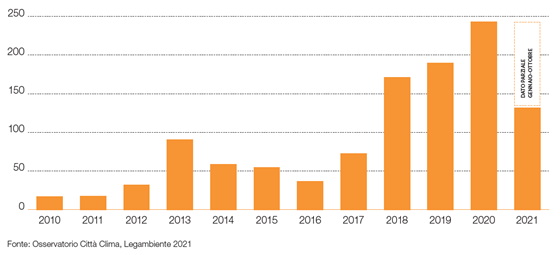
Floods in Italy: January 2010 through October 2021
The most common extreme weather events in Italy are floods:
- Prior to 2018, Italy reported about 10 to 20 flood events per year.
- In 2018 and 2019, Italy reported about 80 flood events per year.
- In 2020, Italy reported about 100 flood events.
- Between January and October 2021, Italy reported 85 flood events, indicating that Italy was about to report more flood events in 2021 than any previous year.
Large hail events in Italy: January 2010 through October 2021
Large hail events are the second-most common extreme weather event in Italy. The European Severe Weather Database defines large hail as the falling of hailstones having a diameter (in the longest direction) of 2.0 cm or more and/or smaller hailstones that form a layer of 2.0 cm thickness or more on flat parts of the earth's surface.
The chart in Figure 2 shows that:
- Prior to 2019, Italy reported less than 200 large hail events per year
- In 2019 and 2020, Italy reported about 500 large hail events per year
- Between January and October 2021, Italy reported 811 large hail events, surpassing 2019’s record-breaking number of hail events
Figure 2: Number of registered large hail events in Italy from 2010 through October 20213
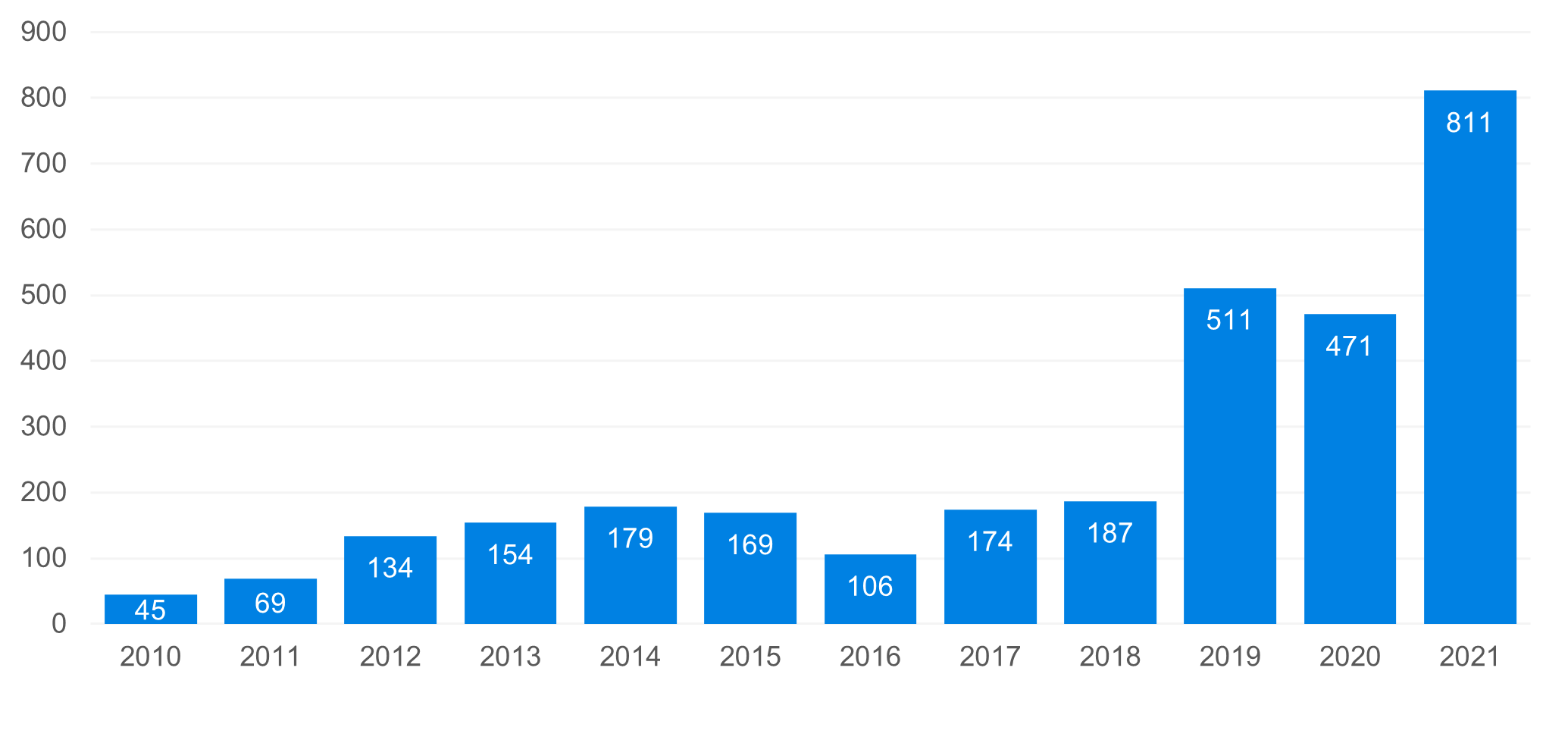
Human loss
From January to October 2021, nine people died in Italy due to extreme weather events. Others were injured or suffered property damage. Specifically:4
- Rapallo (Genova): 120 mm of rain fell in eight hours on 11 April, damaging roads and homes.
- Pantelleria (Trapani): Windstorm on 10 September caused two deaths and four injuries.
- Rossiglione (Genova): 4,740 mm of rain fell in 12 hours on October 4, damaging roads and homes.
- Sicilia: Medicane on 28 October caused three deaths. In meteorology, the Mediterranean tropical cyclone is also referred to as a “medicane,” from the fusion of the words "Mediterranean hurricane."
From 2010 to 2020, 261 deaths were attributed to extreme weather events in Italy. Historically, an increase in floods has not correlated with an increase in victims. Construction innovations and newer preventive measures might account for the substantial reduction in the number of flood-related deaths since the early 1980s. However, flood-related deaths increased significantly from 2009 to 2019, which could be attributed to an increase in extreme weather events.
Economic impact
Italy’s agriculture industry association estimates that the industry lost EUR 2 billion in 2021 due to extreme weather events.5
The Italian government spends about EUR 1.5 billion to manage emergencies related to extreme weather events, but only about EUR 300 million to mitigate weather risks—a 1-to-5 ratio of spending for prevention and damage repair.6
For historical context, Instituto Superiore per la Protezione e la Ricerca Ambientale (ISPRA) compared Italy’s flood losses with the country’s gross domestic product (GDP) from 1995 through 2019, as shown in the chart in Figure 3.
- From 2006, the trend shows that the cost of flood damage was more than 5% of Italy’s annual GDP.
- In 2014, floods losses amounted to 27% of Italy’s GDP.
- Very high losses relative to GDP are not unusual in Italy. For example, the 1996 flood losses amounted to 251% of total GDP and 1972 flood losses amounted to 112% of total GDP.
Figure 3: Economic costs of floods in Italy compared to GDP (1995-2019)
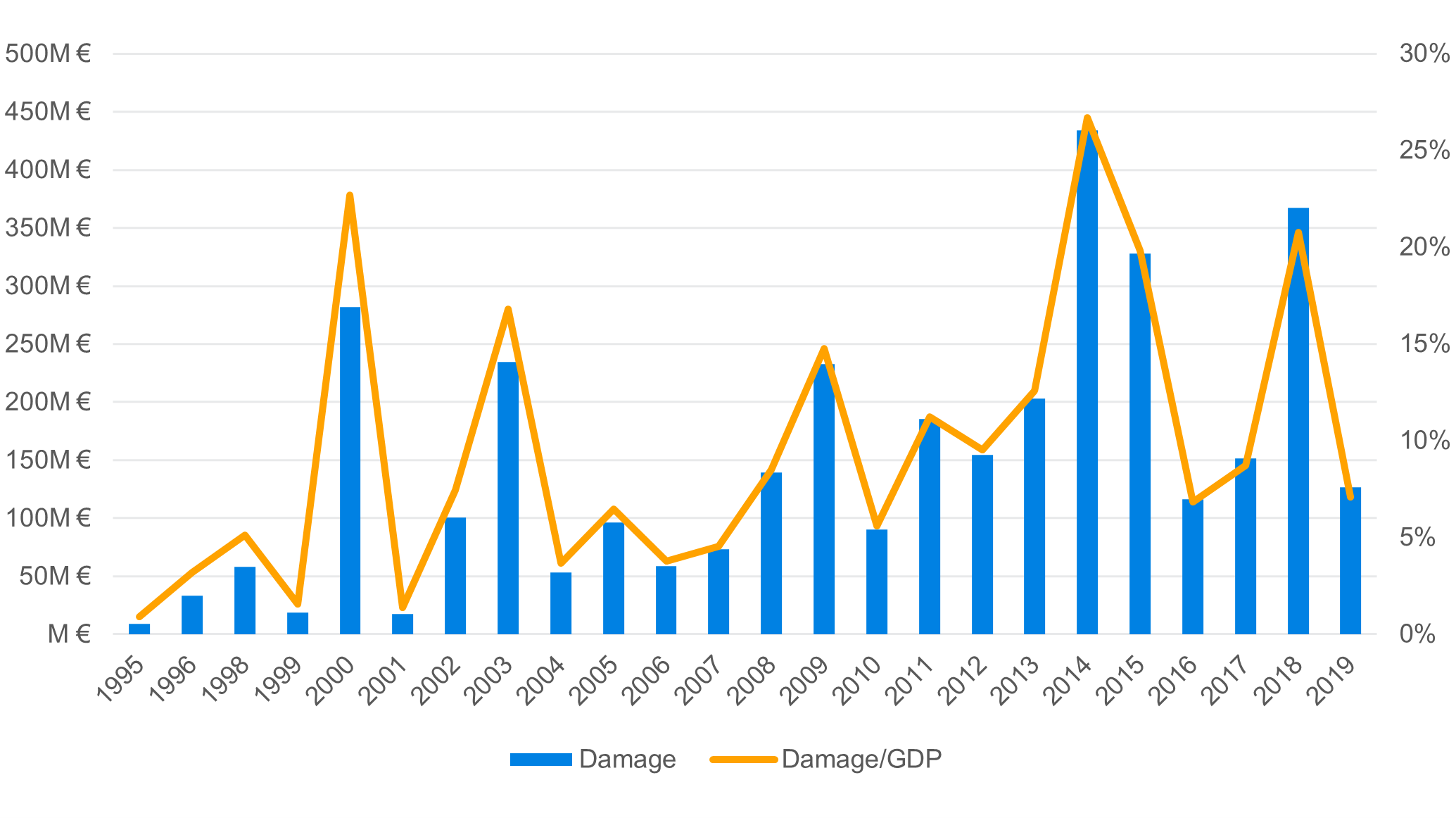
Impact on insurers
The Italian Association of Insurers (ANIA) estimates that only about 2% of properties in Italy are insured in 2021. The lack of coverage leaves the Italian government primarily responsible for the cost of extreme weather events, which has led to rebuilding delays, businesses closing and property abandonment.7
Milliman analysed historical ANIA data8 to show the average cost and claims frequency of hail events in recent years for multi-risk policies, as shown in the chart in Figure 4. The analysis indicates that:- An increase in the number of claims does not always correlate with an increase in costs, except in 2013 and 2019.
- Overall, frequency and costs have been similar in recent years.
- Although 2021 data is not yet available, Milliman expects these trends to continue.
Figure 4: Hail claims frequency and average loss for multi-risk policies
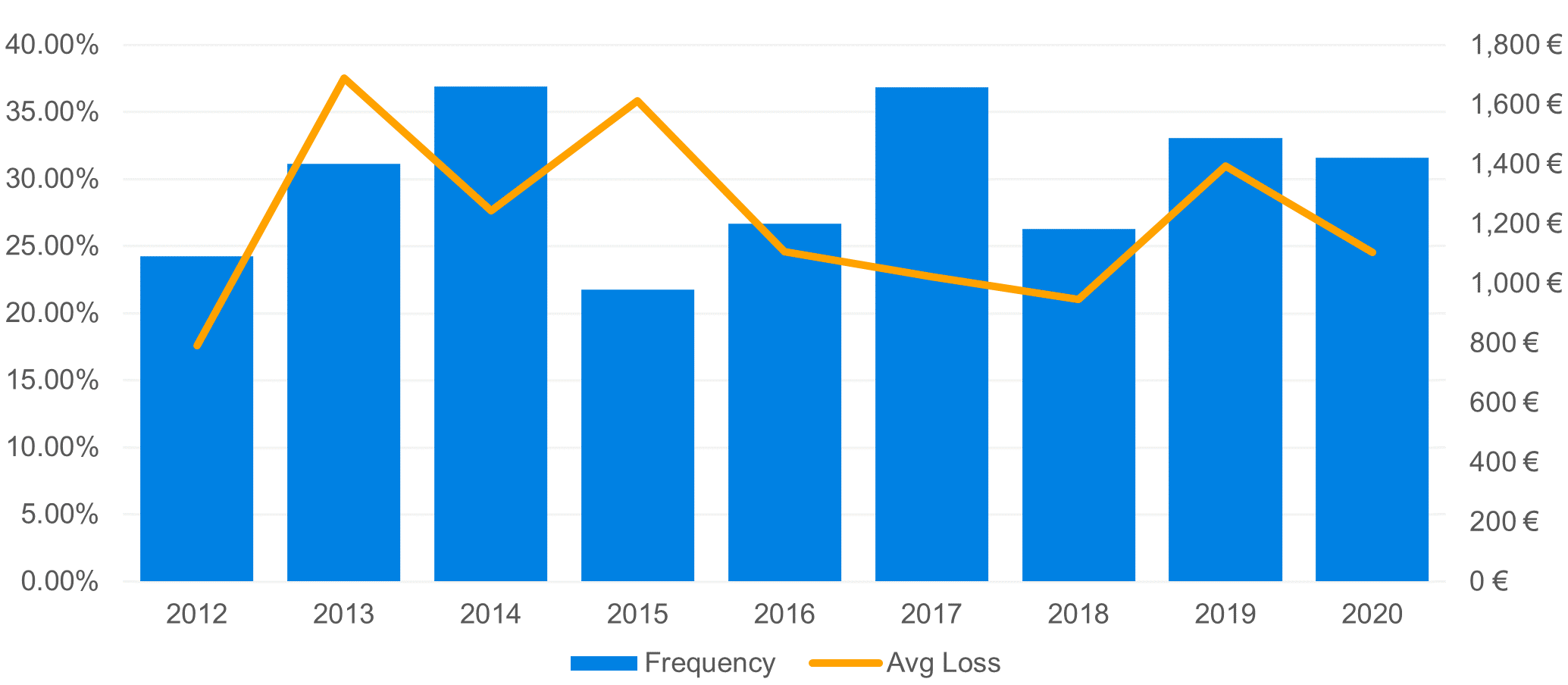
Additionally, ANIA provides annual income statements for claims losses that occurred from 2010 to 2020. Although 2015 and 2016 were countertrend years, insurer losses due to hail events since 2010 follow an increasing trend, as shown in the chart in Figure 5.9
Figure 5: Hail losses for multi-risk policies (claim losses in million)
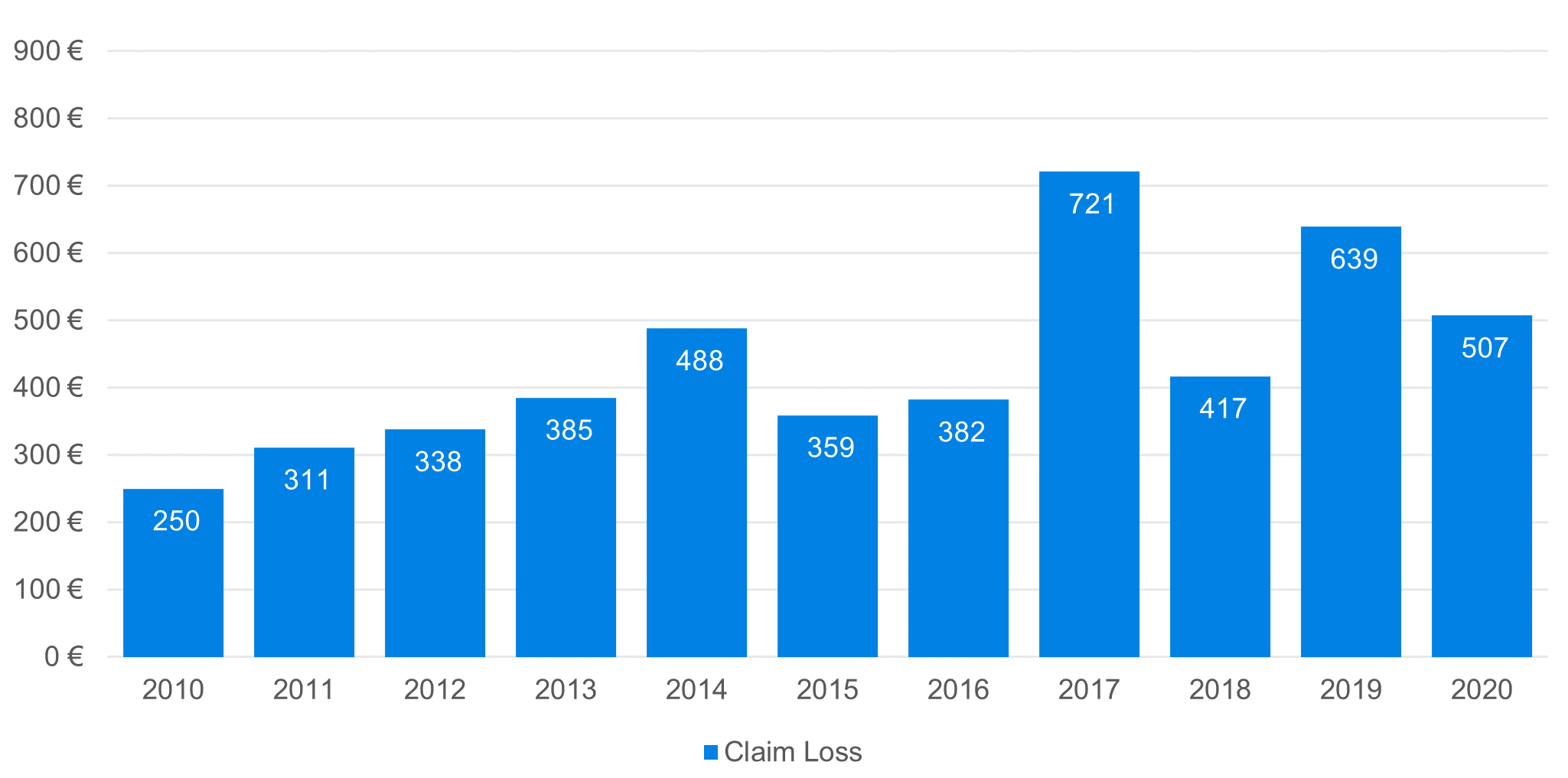
Outlook for the future
The Italian Institute for Environmental Protection and Research reports that:
- Italy is one of Europe’s most at-risk countries for landslides, with about 8% of the nation affected.
- About 4% of Italy is exposed to flood risk, with high-probability scenarios in the next two to 50 years.
- These risks are distributed throughout Italy, with about 91% of municipalities within high to very high landslide hazard zones and/or medium flood hazard zones.
- About 1.3 million people are exposed high to very high landslide risk.
- About 6.2 million people are exposed to high flood risk (return period of 20 to 50 years) and medium flood risk (return period of 100 to 200 years).10
For questions or more information on country-specific climate change and risk management, contact the author listed here or your usual Milliman consultant.
1 European Severe Weather Database. Definitions. Retrieved 11 March 2022 from https://www.eswd.eu/cgi-bin/eswd.cgi?action=showdefinitions&lang=en_0.
2 LEGAMBIENTE. Rapporto 2020. Retrieved 11 March 2022 from https://cittaclima.it/wp-content/uploads/2020/11/CC_Rapporto_2020-def.pdf.
3 LEGAMBIENTE, Rapporto Osservatorio Città-Clima 2021, op cit., pages 15 and 27.
4 The Local (6 October 2021), op cit.
5 LEGAMBIENTE, Rapporto Osservatorio Città-Clima 2021, op cit.
6 ISPRA. Reports Yearbook of Environmental Data. Retrieved 11 March 2022 from https://annuario.isprambiente.it/sys_ind/report/html/404.
7 ANIA. La gestione del rischio catastrofale e stima dei danni al patrimonio abitativo italiano. Retrieved 11 March 2022 from http://www.ordineattuari.it/media/6054/ANIA_280312_CONFORTI_RONCHI_094.pdf.
8 ANIA. Historical statistics on hail for multi-risk policies. Data retrieved 9 December 2021 from https://www.ania.it/pubblicazioni/-/categories/52492.
10 ISPRA. Landslides and floods in Italy: Hazard and risk indicators – 2018 Edition. Retrieved 13 March 2022 from https://www.isprambiente.gov.it/en/publications/reports/landslides-and-floods-in-italy-hazard-and-risk-indicators-2013-2018-edition.